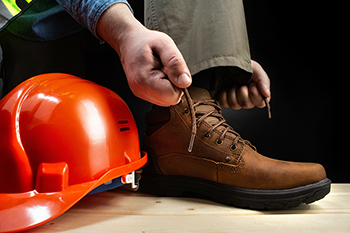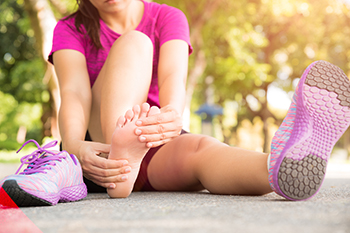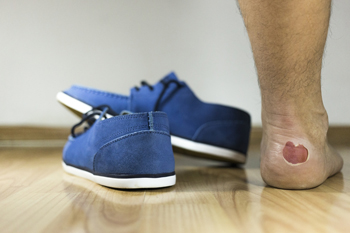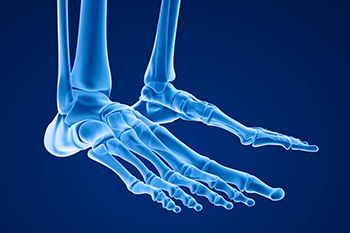December 2022
Falling and the Workplace

Many people fall in their place of employment, which often decreases work productivity. Research has shown that falling is the most common cause of injuries related to work, and it is important to be aware of correct fall prevention techniques. It is the employer's responsibility to have employees understand the dangers of falling and implement changes to the workplace for protection. Scenarios that fall into this category can include covering or guarding floor holes and installing railings around dangerous machines. Additionally, safety nets, stair rails, and handrails can be included in other forms of fall prevention methods. Many employers understand the importance of keeping the work area clean and dry, and it is beneficial to train employees about specific job hazards. If you would like more information about how the feet can become injured during a fall, please speak with a podiatrist who can teach you about effective fall prevention strategies.
Preventing falls among the elderly is very important. If you are older and have fallen or fear that you are prone to falling, consult with one of our podiatrists from Advanced Foot & Ankle Associates, PLLC. Our doctors will assess your condition and provide you with quality advice and care.
Every 11 seconds, an elderly American is being treated in an emergency room for a fall related injury. Falls are the leading cause of head and hip injuries for those 65 and older. Due to decreases in strength, balance, senses, and lack of awareness, elderly persons are very susceptible to falling. Thankfully, there are a number of things older persons can do to prevent falls.
How to Prevent Falls
Some effective methods that older persons can do to prevent falls include:
- Enrolling in strength and balance exercise program to increase balance and strength
- Periodically having your sight and hearing checked
- Discuss any medications you have with a doctor to see if it increases the risk of falling
- Clearing the house of falling hazards and installing devices like grab bars and railings
- Utilizing a walker or cane
- Wearing shoes that provide good support and cushioning
- Talking to family members about falling and increasing awareness
Falling can be a traumatic and embarrassing experience for elderly persons; this can make them less willing to leave the house, and less willing to talk to someone about their fears of falling. Doing such things, however, will increase the likelihood of tripping or losing one’s balance. Knowing the causes of falling and how to prevent them is the best way to mitigate the risk of serious injury.
If you have any questions, please feel free to contact one of our offices located in Lake Worth and Aledo/Willow Park, TX . We offer the newest diagnostic and treatment technologies for all your foot care needs.
What Causes Foot and Toe Cramps?

Anyone who has been jarred awake in the middle of the night by a toe, foot, or leg cramp knows how uncomfortable that can be. A cramp occurs when a muscle involuntarily contracts and is unable to relax. The intense pain caused by a cramp usually goes away, either on its own or by gently massaging or stretching the muscle that is affected. Athletes are most likely to experience foot and toe cramps after long bouts of exercise or other physical activity. High temperatures can also cause cramps from loss of electrolytes, which is a sign of dehydration. Wearing tight shoes or holding a specific position for a long period can bring on cramps, resulting from restricted blood flow. A more serious cause of cramps is arteriosclerosis, which is a constriction of blood flow to the extremities caused by a blockage in the arteries. In some cases, the cramping may be the result of diabetes, nerve damage, or Parkinson’s disease. Cramps may also be caused by deficiencies in certain minerals, such as potassium, calcium, and magnesium. If lower leg, foot, or toe cramps are becoming a regular occurrence, it is wise to visit a podiatrist for a diagnosis and possible treatment options.
Toe pain can disrupt your daily activities. If you have any concerns, contact one of our podiatrists of Advanced Foot & Ankle Associates, PLLC. Our doctors can provide the care you need to keep you pain-free and on your feet.
What Causes Toe Pain?
Most severe toe pain is caused due to a sports injury, trauma from dropping something heavy on the toe, or bumping into something rigid. Other problems can develop over time for various reasons.
Toe pain can be caused by one or more ailments. The most common include:
- Trauma
- Sports injury
- Wearing shoes that are too tight
- Arthritis
- Gout
- Corns and calluses
- Hammertoe
- Bunions
- Blisters
- Ingrown toenails
- Sprains
- Fractures (broken bones)
- Dislocations
When to See a Podiatrist
- Severe pain
- Persistent pain that lasts more than a week
- Signs of infection
- Continued swelling
- Pain that prevents walking
Diagnosis
In many cases the cause of toe pain is obvious, but in others, a podiatrist may want to use more advanced methods to determine the problem. These can range from simple visual inspections and sensation tests to X-rays and MRI scans. Prior medical history, family medical history, and any recent physical traumatic events will all be taken into consideration for a proper diagnosis.
Treatment
Treatments for toe pain and injuries vary and may include shoe inserts, padding, taping, medicines, injections, and in some cases, surgery. If you believe that you have broken a toe, please see a podiatrist as soon as possible.
If you have any questions please feel free to contact one of our offices located in Lake Worth and Aledo/Willow Park, TX . We offer the newest diagnostic tools and technology to treat your foot and ankle needs.
Blisters and Basketball

Blisters can develop on the feet for any number of reasons and there are several different kinds of blisters that may form. Blisters may form in response to repeated pressure or friction on the feet while an individual is playing basketball. If a basketball player is wearing inadequate footwear, then this may also cause blisters. Importantly, blisters are composed of a layer of skin that produces a watery kind of pus. If you have blisters from basketball, it is important to take care of your feet so that the blisters can heal. You might also try to prevent future blisters from developing by wearing basketball shoes that provide enough room in the shoes. You might even be sure to wear socks that properly cover the feet. Contact a podiatrist today for information about blisters from basketball.
Blisters may appear as a single bubble or in a cluster. They can cause a lot of pain and may be filled with pus, blood, or watery serum. If your feet are hurting, contact one of our podiatrists of Advanced Foot & Ankle Associates, PLLC. Our doctors can provide the care you need to keep you pain-free and on your feet.
Foot Blisters
Foot blisters are often the result of friction. This happens due to the constant rubbing from shoes, which can lead to pain.
What Are Foot Blisters?
A foot blister is a small fluid-filled pocket that forms on the upper-most layer of the skin. Blisters are filled with clear fluid and can lead to blood drainage or pus if the area becomes infected.
Symptoms
(Blister symptoms may vary depending on what is causing them)
- Bubble of skin filled with fluid
- Redness
- Moderate to severe pain
- Itching
Prevention & Treatment
In order to prevent blisters, you should be sure to wear comfortable shoes with socks that cushion your feet and absorb sweat. Breaking a blister open may increase your chances of developing an infection. However, if your blister breaks, you should wash the area with soap and water immediately and then apply a bandage to the affected area. If your blisters cause severe pain it is important that you call your podiatrist right away.
If you have any questions, please feel free to contact one of our offices located in Lake Worth and Aledo/Willow Park, TX . We offer the newest diagnostic and treatment technologies for all your foot care needs.
Are Bunions Affecting Your Everyday Life?
The Bones of the Feet

The feet are wonderfully complex parts of the human body. One thing that makes them so complex and interesting is the many different bones that are found in the foot. The feet are composed of 26 different bones that are located throughout the three main areas of the foot known as the hindfoot, the midfoot, and the forefoot. In the forefoot, five metatarsals and their phalanges make up the toes of the feet. These provide critical balancing services to the feet. The midfoot contains bones that are more irregular in shape than the forefoot. For example, in the midfoot, one can find bones such as the medial cuneiform, the lateral cuneiform, and the cuboid bone. Lastly, the hindfoot contains only two bones, the talus, and the calcaneus. Importantly, the calcaneus bone makes up the heel, or back of the foot. If you are interested in learning more about the many different bones of the foot, contact a podiatrist today for more information.
If you have any concerns about your feet, contact one of our podiatrists from Advanced Foot & Ankle Associates, PLLC. Our doctors can provide the care you need to keep you pain-free and on your feet.
Biomechanics in Podiatry
Podiatric biomechanics is a particular sector of specialty podiatry with licensed practitioners who are trained to diagnose and treat conditions affecting the foot, ankle and lower leg. Biomechanics deals with the forces that act against the body, causing an interference with the biological structures. It focuses on the movement of the ankle, the foot and the forces that interact with them.
A History of Biomechanics
- Biomechanics dates back to the BC era in Egypt where evidence of professional foot care has been recorded.
- In 1974, biomechanics gained a higher profile from the studies of Merton Root, who claimed that by changing or controlling the forces between the ankle and the foot, corrections or conditions could be implemented to gain strength and coordination in the area.
Modern technological improvements are based on past theories and therapeutic processes that provide a better understanding of podiatric concepts for biomechanics. Computers can provide accurate information about the forces and patterns of the feet and lower legs.
Understanding biomechanics of the feet can help improve and eliminate pain, stopping further stress to the foot.
If you have any questions please feel free to contact one of our offices located in Lake Worth and Aledo/Willow Park, TX . We offer the newest diagnostic and treatment technologies for all your foot and ankle needs.
Blog Archives
- May 2025
- April 2025
- March 2025
- February 2025
- January 2025
- December 2024
- November 2024
- October 2024
- September 2024
- August 2024
- July 2024
- June 2024
- May 2024
- April 2024
- March 2024
- February 2024
- January 2024
- December 2023
- November 2023
- October 2023
- September 2023
- August 2023
- July 2023
- June 2023
- May 2023
- April 2023
- March 2023
- February 2023
- January 2023
- December 2022
- November 2022
- October 2022
- September 2022
- August 2022
- July 2022
- June 2022
- May 2022
- April 2022
- March 2022
- February 2022
- January 2022
- December 2021
- November 2021
- October 2021
- September 2021
- August 2021
- July 2021
- June 2021
- May 2021
- April 2021
- March 2021
- February 2021
- January 2021
- December 2020
- November 2020
- October 2020
- September 2020
- August 2020
- July 2020
- June 2020
- May 2020
- April 2020
- March 2020
- February 2020
- January 2020
- December 2019
- November 2019
- October 2019
- September 2019
- August 2019
- July 2019
- June 2019
- May 2019
- April 2019
- March 2019
- February 2019
- January 2019
- December 2018
- November 2018
- October 2018





